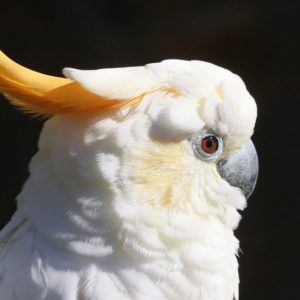Buy Umbrella Cockatoos
The white cockatoo, also known as the Umbrella cockatoo, is a medium-sized all-white cockatoo endemic to tropical rain forest on islands of Indonesia. When surprised, it extends a large and striking head crest, which has a semicircular shape.
Lifespan: 40 – 60 years (In captivity)
Mass: 500 – 630 g Encyclopedia of Life
Kingdom: Animalia
Scientific name: Cacatua alba
Length: 46 cm
Umbrella Cockatoos
The Umbrella cockatoo (Cacatua alba) is one of the large species of cockatoos.
Buy Umbrella Cockatoo Online is around 46 cm (18 in) long, and weighs about 400 g (14 oz) for small females and up to 800 g (28 oz) for big males. The male white cockatoo usually has a broader head and a bigger beak than the female. They have brown or black eyes and a dark grey beak. When mature some female white cockatoos can have reddish/brown irises, while the irises of the adult male are dark brown or black.
The feathers of the white cockatoo are mostly white. However, both upper and lower surfaces of the inner half of the trailing edge of the large wing feathers are a yellow colour. The yellow colour on the underside of the wings is most notable. This is because the yellow portion of the upper surface of the feather is covered. It is covered by the white of the feather immediately medial (nearer to the body) and above. Buy Umbrella Cockatoo Online. Similarly, areas of larger tail feathers that are covered by other tail feathers. Also the innermost covered areas of the larger crest feathers are yellow. Short white feathers grow from and closely cover the upper legs. The feathers of this species and others create a powder similar to talcum powder that easily transfers to clothing.
WHITE COCKATOO
In common with other cockatoos and parrots, the white cockatoo has zygodactyl feet with two toes facing forward and two facing backward. They enable it to grasp objects with one foot while standing on the other, for feeding and manipulation.
The maximum lifespan of the white cockatoo is poorly documented. A few zoos report that they live between 40–60 years in captivity. Anecdotal reports suggest it can live longer. Lifespan in the wild is unknown, but believed to be as much as ten years less.














Reviews
There are no reviews yet.